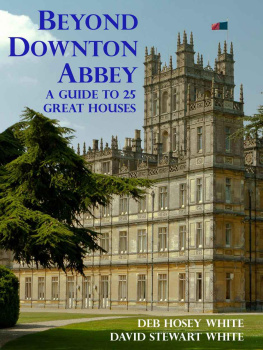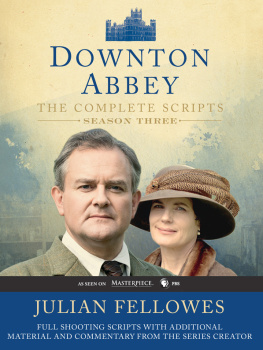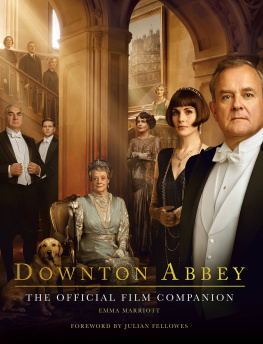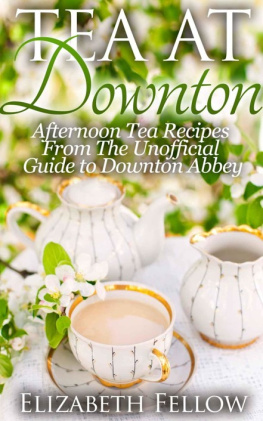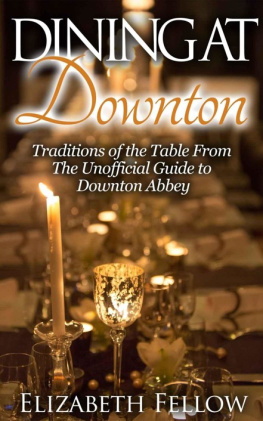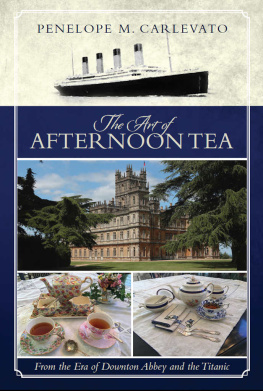White Deb Hosey - Beyond Downton Abbey, Volume 1
Here you can read online White Deb Hosey - Beyond Downton Abbey, Volume 1 full text of the book (entire story) in english for free. Download pdf and epub, get meaning, cover and reviews about this ebook. year: 2012, publisher: White & Associates, genre: Detective and thriller. Description of the work, (preface) as well as reviews are available. Best literature library LitArk.com created for fans of good reading and offers a wide selection of genres:
Romance novel
Science fiction
Adventure
Detective
Science
History
Home and family
Prose
Art
Politics
Computer
Non-fiction
Religion
Business
Children
Humor
Choose a favorite category and find really read worthwhile books. Enjoy immersion in the world of imagination, feel the emotions of the characters or learn something new for yourself, make an fascinating discovery.
- Book:Beyond Downton Abbey, Volume 1
- Author:
- Publisher:White & Associates
- Genre:
- Year:2012
- Rating:4 / 5
- Favourites:Add to favourites
- Your mark:
- 80
- 1
- 2
- 3
- 4
- 5
Beyond Downton Abbey, Volume 1: summary, description and annotation
We offer to read an annotation, description, summary or preface (depends on what the author of the book "Beyond Downton Abbey, Volume 1" wrote himself). If you haven't found the necessary information about the book — write in the comments, we will try to find it.
Beyond Downton Abbey is a guide to 25 great houses in Britain
Beyond Downton Abbey, Volume 1 — read online for free the complete book (whole text) full work
Below is the text of the book, divided by pages. System saving the place of the last page read, allows you to conveniently read the book "Beyond Downton Abbey, Volume 1" online for free, without having to search again every time where you left off. Put a bookmark, and you can go to the page where you finished reading at any time.
Font size:
Interval:
Bookmark:
Beyond Downton Abbey
A Guide To 25 Great Houses
- By
Deb Hosey White
and
David Stewart White
Also by the authors
Let's Take the Kids to London
by David Stewart White
Pink Slips and Parting Gifts
by Deb Hosey White
Beyond Downton Abbey
A Guide To 25 Great Houses
By
Deb Hosey White
and
David Stewart White
All Rights Reserved 2012 by White & Associates
ISBN: 978-0-9829179-3-0
For more information about this book, please visit our website at
www.BeyondDowntonAbbey.com
Cover image by Richard Munckton
Creative Commons License
Opening The Manor House Door

photo by George Grinsted (Creative Commons license)
The popular television series Downton Abbey is just the start. Britain is filled with historic houses, castles and palaces. Join us as we take you Beyond Downton Abbey to dozens of the grandest, most romantic, quirkiest great houses in England and Wales. Filled with fascinating tidbits from the history of the houses and the families that lived and worked in them, Beyond Downton Abbey is a guidebook for serious travelers and armchair tourists alike.
A bit of history to set the stage
Manor houses. Stately homes. Country house estates. Great houses. Grand old piles. Spectacular mansions. Country retreats. These are all terms used to describe the hundreds of historic houses scattered across the British countryside.
Some historic properties have timelines that date back 500 years or more, but most British manor houses were built between the mid-1600s and the late 1700s. The heyday of the manor house lifestyle reached its zenith during the 18 th and 19 th centuries when the old landed families and the new captains of industry enjoyed their wealth, looked after by a retinue of servants. The Edwardian era 1900 to 1914 marked a last brief, shining moment for the manor house lifestyle and ushered in a quick and serious decline for many historic houses.
The British ruling class survived and thrived for a thousand years. What was their formula for success? The titled class owned over half of all the land in the country; and more land equated to more power and resulted in more wealth, with tenants on the land paying rents to the landowners.
Among the ruling class, breeding was paramount in matters of family, horses and dogs. Generations of British aristocracy dominated the economy, politics, culture and society. Since by law the land could not be sold, only inherited through an established system called primogeniture (first son inherits all), few ever imagined how quickly the aristocracy would unravel.
The national power structure began to shift, triggered by the loss of a significant portion of a generation of British men from all classes. The shift was fueled by Suffragettes seeking female equality and stoked by the emergence of the Labor party pushing for better pay and working conditions. By World War II, the British aristocracy was a shell of its former self, much as the great houses an emblem of its wealth were falling into decline.
In the mid-1940s, country houses in Britain were being demolished at a rate of up to one per week. Although many stately homes were lost to decay and development during the mid-20 th century, hundreds were rescued by individuals and by organizations such as English Heritage, the National Trust, the Heritage Conservation Trust, and the Historic Houses Association. Still other homes have continued to be owned by new generations of aristocratic families, keen on sustaining their properties by opening them to the public or adding new commercial enterprises. In todays world, inheritors of great estate houses often find themselves asset rich (with huge, exquisite homes and vast lands), but cash poor (facing monumental maintenance costs, operating challenges and tax bills).
The stories that make us want more
Many Britons and Anglophiles alike continue to be enthralled with these special places and their architectural wonders, gardens, estate parks, furnishings and art. But clearly, even more fascinating are the people who inhabited these great homes and the relationships among masters and the serving class. In Britain, curiosity about those relationships is understandable. Setting aside the gentry class, a wide swath of the population can trace family ancestry to people who were once in domestic service. For example, the 1891 census recorded more than 1.5 million people were working as house servants in Britain.
Thanks to the works of authors such as Charlotte Bronte, George Eliot, Sir Arthur Conan Doyle, and Charles Dickens, along with productions by the BBC, Masterpiece, and others, Europeans and Americans have enjoyed a long list of costume dramas set in stately homes. Captivated by the lives and times of the British aristocracy, royalty, and the servants to the British upper class, the appeal of these stories and settings seems everlasting. Although our most recent focus is Downton Abbey , before it came many others including The Tudors miniseries, Pride and Prejudice , and in the early 1970s, the TV series Upstairs, Downstairs .
Beyond Downton Abbey
Place. A sense of place.
Creator Julian Fellowes could have named his miniseries The Granthams , The Edwardians , Heir to the Abbey , or The Young Ladies of Downton . But he didnt. Instead, he named it for the great house where most of the series action takes place. Even the logo for the miniseries and the opening shot of each episode are all about the great pile of a house fictionally known as Downton Abbey.
Ardent fans of the series know in the real world this historic estate home is named Highclere Castle and is located in Hampshire, not Yorkshire. Those whove done their research know that Highcleres history, though quite fascinating, has little to do with the invented storyline of Downton Abbey. But the Downton Abbey storyline, while fiction, is often repeated in great houses across Britain.
We hope you enjoy these 25 great houses, 25 stories, and 25 reasons to visit.
Highclere A Masterpiece Classic
This isnt just a film setits also our home.Lady Fiona Carnarvon, quoted in Time magazine

photo by Mike Searle (Creative Commons license)
Thanks to the international popularity of a new miniseries, Highclere Castle has become one of the worlds most recognizable great houses. The hugely successful drama Downton Abbey has made Highclere into a tourist magnet in south central England.
Downton Abbey may be why tourists come, but their experience here is the very real story of Highclere Castle and the Carnarvon family who own and nurture this iconic estate. Truth be told, there are some similarities between Downtons fictional Crawley family and Highcleres Carnarvons. That story is the subject of Lady Almina and the Real Downton Abbey , a book penned by the current Countess of Carnarvon.
Who built itwho owns it
A medieval palace owned by the powerful Bishops of Winchester once stood on the site of Highclere Castle, but since 1679, Highclere has been the domain of the Carnarvon family. Renovated in the 1700s and early 1800s, Highclere evolved into a classical square Georgian mansion, then was transformed into a Jacobethan castle by Sir Charles Barry, architect of Londons Houses of Parliament. The makeover from mansion to castle began in 1839 and lasted until 1878.
A more purposeful transformation happened here during the First World War when Highclere became a hospital for wounded soldiers until 1922.
Next pageFont size:
Interval:
Bookmark:
Similar books «Beyond Downton Abbey, Volume 1»
Look at similar books to Beyond Downton Abbey, Volume 1. We have selected literature similar in name and meaning in the hope of providing readers with more options to find new, interesting, not yet read works.
Discussion, reviews of the book Beyond Downton Abbey, Volume 1 and just readers' own opinions. Leave your comments, write what you think about the work, its meaning or the main characters. Specify what exactly you liked and what you didn't like, and why you think so.

